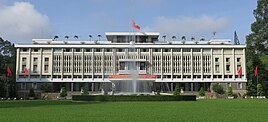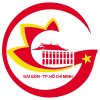
Back Kota Ho Chi Minh ACE Ho Chi Minh-stad Afrikaans Ho-Chi-Minh-Stadt ALS ሆ ቺ ሚን ከተማ Amharic Ciudat Ho Chi Minh AN Ho Chi Minh Burg ANG مدينة هو تشي منه Arabic هو تشى مينه ARZ Ciudá Ho Chi Minh AST Ho Chi Min marka Aymara
You can help expand this article with text translated from the corresponding article in Vietnamese. (February 2024) Click [show] for important translation instructions.
|
Ho Chi Minh City
Thành phố Hồ Chí Minh Saigon (Sài Gòn) | |
|---|---|
| Nicknames: | |
| Motto(s): | |
 Interactive map outlining Ho Chi Minh City | |
| Coordinates: 10°46′32″N 106°42′07″E / 10.77556°N 106.70194°E | |
| Country | |
| Region | Southeast |
| Founded | 1698 |
| Founded by | Nguyễn Hữu Cảnh |
| Named for | Ho Chi Minh |
| Districts | 16 urban districts, 5 rural districts and 1 sub-city |
| Government | |
| • Type | Municipality |
| • Body | Ho Chi Minh City People's Council |
| • Secretary of CPV | Nguyễn Văn Nên |
| • Chairwoman of People's Council | Nguyễn Thị Lệ |
| • Chairman of People's Committee | Phan Văn Mãi |
| Area | |
| • Municipality | 2,095.39 km2 (809.03 sq mi) |
| • Metro | 30,595 km2 (11,813 sq mi) |
| Elevation | 19 m (63 ft) |
| Population (2023) | |
| • Municipality | 9,320,866 (1st) |
| • Density | 4,375/km2 (11,330/sq mi) |
| • Metro | 21,281,639 (1st) |
| • Metro density | 697.2/km2 (1,806/sq mi) |
| Demonym | Saigonese |
| GDP (2018)[4] | |
| • Municipality | US$ 57.3 billion |
| • Metro | US$ 94.3 billion |
| Time zone | UTC+07:00 (ICT) |
| Postal code | 700000–740000 |
| Area codes | 28 |
| ISO 3166 code | VN-SG |
| License plate | 41, 50–59 |
| HDI (2020) | 0.795 (2nd)[5] |
| International airports | Tan Son Nhat International Airport (SGN) |
| Rapid transit system | Ho Chi Minh City Metro |
| Website | hochiminhcity |
Ho Chi Minh City (HCMC, Vietnamese: Thành phố Hồ Chí Minh), commonly known as Saigon (Vietnamese: Sài Gòn), is the most populous city in Vietnam, with a population of around 9.3 million in 2023.[6] The city's geography is defined by rivers and canals, of which the eponymously-named Saigon River is the largest. As a municipality, Ho Chi Minh City consists of 16 urban districts, five rural districts, and one municipal city (sub-city). As the largest financial centre in Vietnam, Ho Chi Minh City has the highest gross regional domestic product out of all Vietnam provinces and municipalities,[7] contributing around a quarter of the country's total GDP.[8] Ho Chi Minh City's metropolitan area is ASEAN's 6th largest economy, also the biggest outside an ASEAN country capital.
Since the early times, water transport has been heavily used by inhabitants in the area. The area was occupied by Champa from 2nd century AD to around the 19th century, due to Đại Việt's expanist policy of Nam tiến. After the fall of Citadel of Gia Định, Saigon was the capital of French Indochina from 1887 to 1902, and again from 1945 until its cessation in 1954. Following the partition of French Indochina, it became the capital of South Vietnam until it was captured by North Vietnam, who renamed the city after their former leader Hồ Chí Minh, though the former name is still widely used in informal usages. Beginning in the 1990s, the city underwent rapid expansion and modernization, which contributed to Vietnam's post-war economic recovery and helped revive its international trade hub status.
Ho Chi Minh City has a long tradition of being a productive trading and manufacturing place in Vietnam. As such, the city is also the busiest international transport hub in Vietnam, as Tân Sơn Nhất International Airport accounts for nearly half of all international arrivals to Vietnam[9] and the Port of Saigon is among the busiest container ports in Southeast Asia.[10] Ho Chi Minh City is also a popular tourism destination. Some of the war and historic landmarks in the city include the Independence Palace, Landmark 81 (tallest building in Vietnam), the War Remnants Museum, and Bến Thành Market. The city is also known for its narrow walkable alleys and night life. Currently, Ho Chi Minh City is facing increasing threats of sea level rise and flooding as well as heavy strains on public infrastructures.
- ^ "Saigon, Paris of the Orient, shows war tarnish". Lodi News-Sentinel. 7 April 1971. Archived from the original on 8 December 2015.
- ^ Cherry, Haydon (2019). Down and Out in Saigon: Stories of the Poor in a Colonial City. Yale University Press. p. 29. ISBN 978-0-300-21825-1.
- ^ https://monre.gov.vn/VanBan/Lists/VanBanChiDao/Attachments/3012/b4.5_Signed.pdf (PDF). Phê duyệt và công bố kết quả thống kê diện tích đất đai năm 2022 [Approve and announce the results of land area statistics in 2022] (Decision 3048/QĐ-BTNMT, Table 4.5) (in Vietnamese). Ministry of Natural Resources and Environment (Vietnam). 18 October 2023.
{{cite report}}:|article-url=missing title (help) – the data in the report are in hectares, rounded to integers - ^ "Tình hình kinh tế, xã hội TP. Hồ Chí Minh năm 2018". Bộ Kế hoạch và Đầu tư. Archived from the original on 2 April 2019. Retrieved 10 May 2020.
- ^ General Statistics Office of Vietnam (2021). Báo cáo Chỉ số phát triển con người Việt Nam giai đoạn 2016 – 2020 [Vietnam's Human Development Index (2016-2020)] (PDF) (Report). pp. 29–30. Archived (PDF) from the original on 8 October 2022. Retrieved 10 March 2023.
- ^ Cite error: The named reference
2019censuswas invoked but never defined (see the help page). - ^ "Đóng góp của các tỉnh, thành phố về một số chỉ tiêu chủ yếu". kinhtetrunguong.vn (in Vietnamese). 20 March 2023. Retrieved 7 January 2024.
- ^ Onishi, Tomoya. "Vietnam to boost Ho Chi Minh budget for first time in 18 years". Nikkei Asia. Retrieved 30 August 2022. (Subscription required.)
- ^ "Military land approved for new Tan Son Nhat airport terminal". VnExpress. Retrieved 30 August 2022.
- ^ "Three Vietnamese seaports among top 100 largest container ports worldwide". General Statistics Office of Vietnam. Retrieved 27 December 2023.
© MMXXIII Rich X Search. We shall prevail. All rights reserved. Rich X Search









